Debunking Solar Energy Fears
Air Date: Week of November 24, 2023

Solar panel applications and technology continue to grow. Above, a floating solar panel is assembled for a water retention pond in Walden, Colorado. (Photo: National Renewable Energy Lab, Flickr, CC BY-NC-ND 2.0)
As solar energy costs fall and installations of solar panels rise, some are raising concerns about the materials they’re made from and are promoting disinformation about the safety of recycling these modules. A team at the National Renewable Energy Laboratory clarified this waste from solar panels and recently published an essay in the journal Nature Physics. Lead author Dr. Heather Mirletz joins Host Jenni Doering to put solar panel waste in perspective.
Transcript
DOERING: The International Energy Agency says today’s solar panels generate the cheapest electricity in history. Solar technology has greatly improved and allowed the cost of utility-scale systems to plummet over the last decade by an astonishing 80%. But as installations of photovoltaic, or PV, modules have risen, some have raised concerns about the materials they’re made from and promoted disinformation about the safety of recycling these modules. A team at the National Renewable Energy Laboratory or NREL in Colorado clarified this waste from solar panels and recently published an essay in the journal Nature Physics. One of the authors, Dr. Heather Mirletz, just earned her PhD from the Advanced Energy Systems Graduate program based at the Colorado School of Mines and NREL. Welcome to Living on Earth, Heather – and congratulations on your new degree!
MIRLETZ: Thank you so much. I really appreciate that.
DOERING: So first, a little background, what exactly are solar panels made of?
MIRLETZ: Yeah. So the modern solar panel that you would see driving on the highway in a big field, or maybe on your neighbor's roof or your roof is going to be a crystalline silicon module, that's a module that is mostly glass. So you've got a glass on the front and glass in the back, or you'll have a glass front sheet for the light to come through with a plastic back sheet, then in the middle, you'll have some sheets of plastic that you sort of melt them like cheese, to stick the whole package of a sandwich together. And then in the middle of that, you've got these silicon wafer cells. And they are what actually take in the rays of sun and turn them into electrons for all of us to use.

Mirletz H.M. et al. (2023) found that quantities of waste produced from other sectors of our daily lives will far exceed that produced from photovoltaic modules through at least 2050. (Photo: Courtesy of Mirletz et al.)
DOERING: And what's the misinformation about solar panels and their wastes that you describe in your paper?
MIRLETZ: We saw a number of headlines going by and a lot of concern in the literature about the toxicity of PV waste and the large quantity that's that we're going to imminently appear in our world, and we were going to have to manage, and we're very concerned about that, because it didn't seem to fit with the knowledge that we had about PV and its lifetimes, and certainly its toxicity levels. So we set out to have a better view of what the amount of PV waste was actually going to be, and then put that in a little bit of context. So we have a newly updated model with all of the modern reliability data of how long a PV module actually lasts these days, and projected out through 2050, that there will be somewhere between 54 million metric tons and 160 million metric tons of cumulative PV modules coming out of the field by 2050. That sounds like a lot. And that's a fairly wide range, because that's dependent on sort of different lifetimes. So the high range is a short lifetime. We don't think that's very probable the 160 million metric tons is a 20 year lifetime, which is a decade shorter than what current industry standards are. So we don't think that that's very probable it's going to be less than that. And then so it'll be closer to the 54 million metric tons.
DOERING: Okay, so can you compare that to say fossil fuel waste or household waste?
MIRLETZ: What we found is that the amount of PV waste is absolutely dwarfed by all of these other wastes that we manage on a daily, monthly, yearly basis. For municipal waste or coal ash, you're getting up to 1000s of times the amount of PV waste that you would get. So it's not a crisis in any capacity.

As demand for solar energy has grown, so has misinformation surrounding its potential for waste and toxicity. (Photo: Ninara, Flickr, CC BY 2.0)
DOERING: Of course, the amount of waste that we're producing from fossil fuels or solar panels, you know, decades down the road, really depends on the kind of world that we're creating and how much energy we're continuing to use from fossil fuels versus from solar. So what sort of numbers did you use in your paper?
MIRLETZ: For this, we assumed that the PV model has a projection that would include deployment scale to decarbonize our energy sector. So we're looking at this as a global scale. So what we targeted was 75 terawatts by 2050. For a little bit of context on that number, we just passed one terawatt of PV installed globally last year. So that's a humongous scale up, we're going to need a lot of materials to do that. But they're all going to be in the field in 2050. They're not coming out by 2050. So for the municipal waste, and the coal ash, I took a very simple assumption. And I said, Okay, we're not going to change anything about what we're currently doing, or what we're currently generating for plastic waste, or coal ash or anything like that. What is it that we generate this year, and held that constant through 2050? And how much waste does that generate in the process of keeping that constant? So really, what this is kind of demonstrating is this is the trade off between this is the amount of coal ash that we could produce if we don't change our energy system, or we can have this much smaller amount of PV waste by 2050. If we do change our energy system.
DOERING: And of course, there's the sheer amount of waste, but there's also toxicity. So how does that compare between like coal ash versus solar panels?
MIRLETZ: So the toxicity is a really important aspect of this. It is known that coal ash, oily sludge, a variety of other byproducts of current fossil fuel generation are highly toxic wastes. For a solar panel, we really wanted to be clear on exactly what materials are there because we were finding some state governments that had lists of toxic materials in the PV module that made us raise our eyebrow and say, I don't think that's in there. So we went through the list and tried to figure out why that had been put on the list and to also double check the bill of materials of our modern crystal and silicone module, just to make sure that wasn't actually in there. So the one element that does exist in current modern silicon modules is lead. There is a very, very tiny amount of lead in a coating on a wire in the module for doing the soldering electrical interconnects between the cells, we're talking less than point zero 1% biomass of a module, it is absolutely miniscule, it's also very well encapsulated, it's very hard to get that out. So that is the only element that we are aware of for modern crystalline silicon module that is toxic. The other things that we were seeing listed included arsenic and gallium, those are actually associated with a different PV technology. They're only deployed for space applications. So they only end up in outer space. Some of the other ones we saw were selenium and germanium. Again, these are part of other technologies that are either laboratory scale, old, outdated, not deployed at scale, these are not the things that you're going to be seeing in the field on your roof. These are not commercially available.

Plastic waste was just one of several categories that were shown to outnumber the waste produced by PV modules. (Photo: Ivan Radic, Flickr, CC BY 2.0)
DOERING: So it's just fascinating to hear from you and to read in your paper that several US state health departments actually have this outdated information and incorrect information about potential toxins and solar panels. Why is that?
MIRLETZ: Yeah, we're not entirely sure. But it is a consistent list between the different state departments that we saw this. So it's possible that they just shared, you know, one State Department has a list and best practice is frequently to use the information that you can have available to you. So that's possibly where that consistency between the different state departments came from. But I think it really stems from there's been a lack of easily accessible, well communicated information. And that's really what we were trying to address.
DOERING: And what kinds of impacts do you think misinformation about solar panel waste is having on the solar and clean energy industries?
MIRLETZ: Yeah, we are definitely seeing bands coming in because of concerns over toxicity. There's a lot of pushback from communities who say, we don't want this here, because we don't want toxins in our neighborhood. And I totally agree, I wouldn't want toxins in my neighborhood either. And so that is actively slowing the deployment of PV that is really necessary for us to achieve energy transition and to decarbonize. And what I'd like to hope is that this paper is showing how not only does PV present an opportunity for waste reduction, but also toxicity reduction in comparison to our current system. And that this is a really wonderful opportunity instead of something to be afraid of.
DOERING: Can you explain the lifetime of a solar panel and why that's important to factor in?
MIRLETZ: Absolutely. So lifetime reliability is really important to the sustainability of a PV module, most of our modern modules last certainly upwards of 25. And we're seeing upwards of 30 years, I don't think that a 45 year module, technical lifetime is at all out of our reach, there is a target from the Department of Energy Solar Energy Technology Office to reach for a 50 year technical lifetime module. And those longer lived modules decrease the overall amount of modules that we need for deploying for energy transition, because if they're still there, you don't need to replace them. So you just need fewer modules overall, which is a really wonderful thing in terms of reducing material impacts on the front side.

Some solar panels are only deployed for space applications. The solar panel pictured provides power to the International Space Station. (Photo: NASA Marshall Space Flight Center, Flickr, CC BY-NC 2.0)
DOERING: Now, what usually happens to solar panels when they have reached the end of their useful life?
MIRLETZ: All of them have an end of life plan when they are installed. It's frequently a part of the requirements of the installation or the lease of the land. Much of the time, they will end up in a landfill right now, because the recycling processes are still fairly nascent. It's something that we are actively working on improving. There's a lot of companies working in this space, a lot of activity going on in researching how to do this better. And part of the toxicity and concerns about that actually hinder our ability to make the recycling more widescale, because if it's deemed as a toxic material, that means that the burden on the recycler is much, much higher to have all of these safety checks in place, even if they aren't actually necessary because it's not toxic material.
DOERING: How is solar panel technology and manufacturing improving?
MIRLETZ: Yeah, we've gotten so much better at making PV modules, they used to be much thicker and much heavier, lifetimes have steadily increased over that time. And efficiencies have also very steadily increased over that time, and the industry only gets better at doing it and doing it more cost effectively and doing it with less material. Energy payback times, partially from material reduction and partially from efficiency. Improvements have meant that in the space of a year, the energy that you put into a module has paid itself back.
DOERING: Dr. Heather Mirletz is a recent graduate of the Colorado School of Mines and the National Renewable Energy Laboratory. Thank you so much, Heather.
MIRLETZ: Thank you.
Links
NREL | “Documenting a Decade of Cost Declines for PV Systems”
DOE Office of Energy Efficiency and Renewable Energy | “End of Life Management for Photovoltaics”
Living on Earth wants to hear from you!
Living on Earth
62 Calef Highway, Suite 212
Lee, NH 03861
Telephone: 617-287-4121
E-mail: comments@loe.org
Newsletter [Click here]
Donate to Living on Earth!
Living on Earth is an independent media program and relies entirely on contributions from listeners and institutions supporting public service. Please donate now to preserve an independent environmental voice.
NewsletterLiving on Earth offers a weekly delivery of the show's rundown to your mailbox. Sign up for our newsletter today!
 Sailors For The Sea: Be the change you want to sea.
Sailors For The Sea: Be the change you want to sea.
 The Grantham Foundation for the Protection of the Environment: Committed to protecting and improving the health of the global environment.
The Grantham Foundation for the Protection of the Environment: Committed to protecting and improving the health of the global environment.
 Contribute to Living on Earth and receive, as our gift to you, an archival print of one of Mark Seth Lender's extraordinary wildlife photographs. Follow the link to see Mark's current collection of photographs.
Contribute to Living on Earth and receive, as our gift to you, an archival print of one of Mark Seth Lender's extraordinary wildlife photographs. Follow the link to see Mark's current collection of photographs.
 Buy a signed copy of Mark Seth Lender's book Smeagull the Seagull & support Living on Earth
Buy a signed copy of Mark Seth Lender's book Smeagull the Seagull & support Living on Earth

